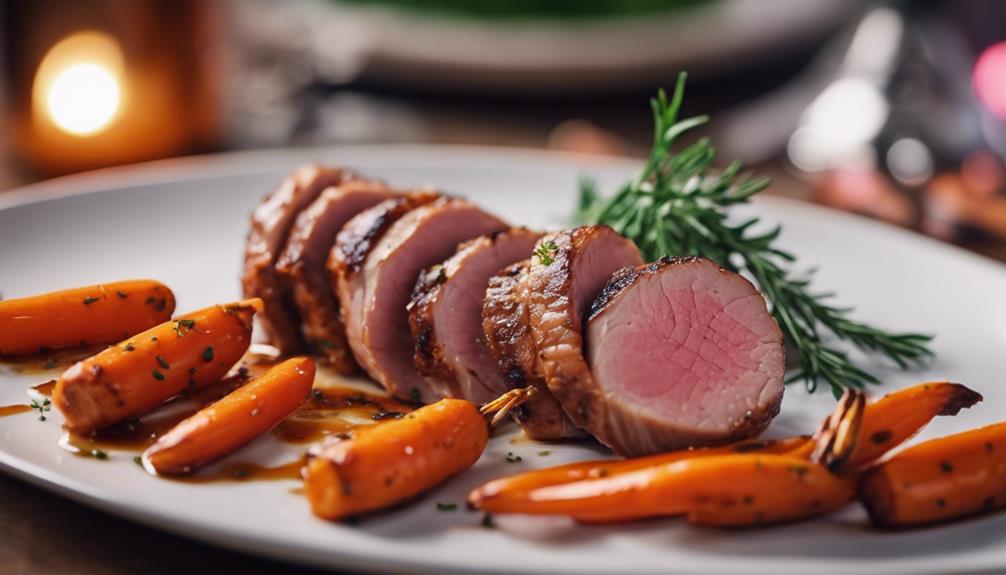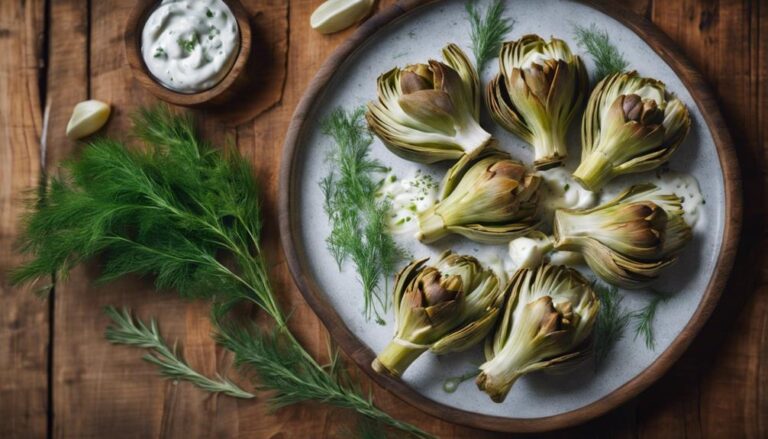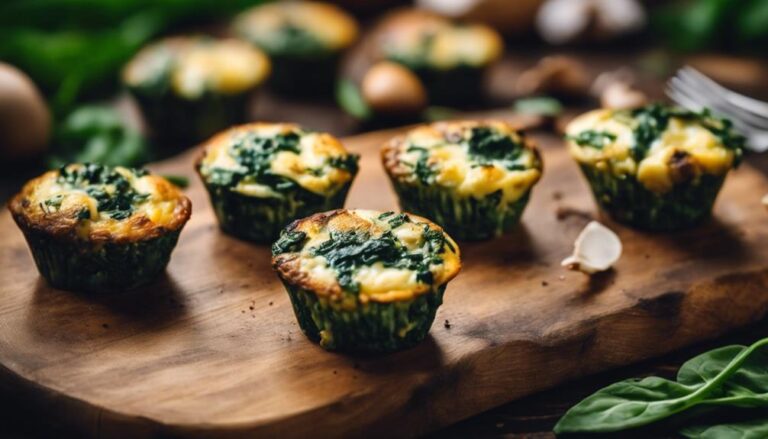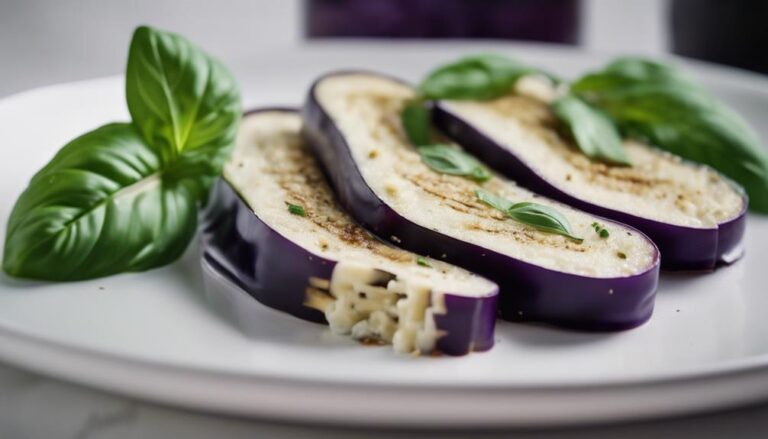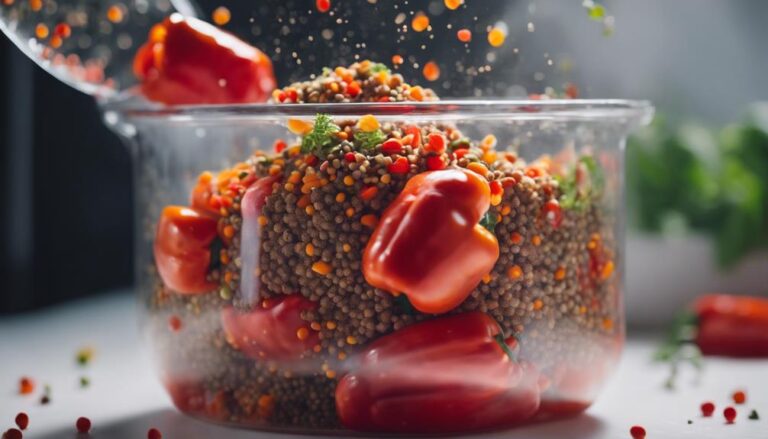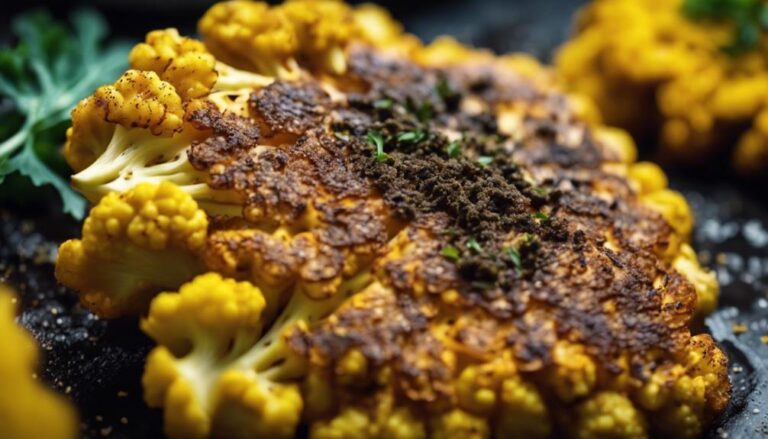Sous Vide Pork Tenderloin With Roasted Carrots
Achieve culinary perfection: Sous vide pork tenderloin with roasted carrots. Seal pork with herbs and citrus for flavor infusion. Cook sous vide for juicy, tender meat. Roast carrots with a hint of sweetness. Sear pork post sous vide for a caramelized crust. The perfect fusion of succulent pork and caramelized carrots awaits.
What You Will Learn Here
- Sous vide pork tenderloin ensures juicy, perfectly cooked meat.
- Roasted carrots complement the dish with caramelized sweetness.
- Season pork with herbs and spices for enhanced flavor.
- Sear pork for a crispy crust after sous vide cooking.
- Precision temperature control is crucial for optimal results.
Sous Vide Cooking Origins
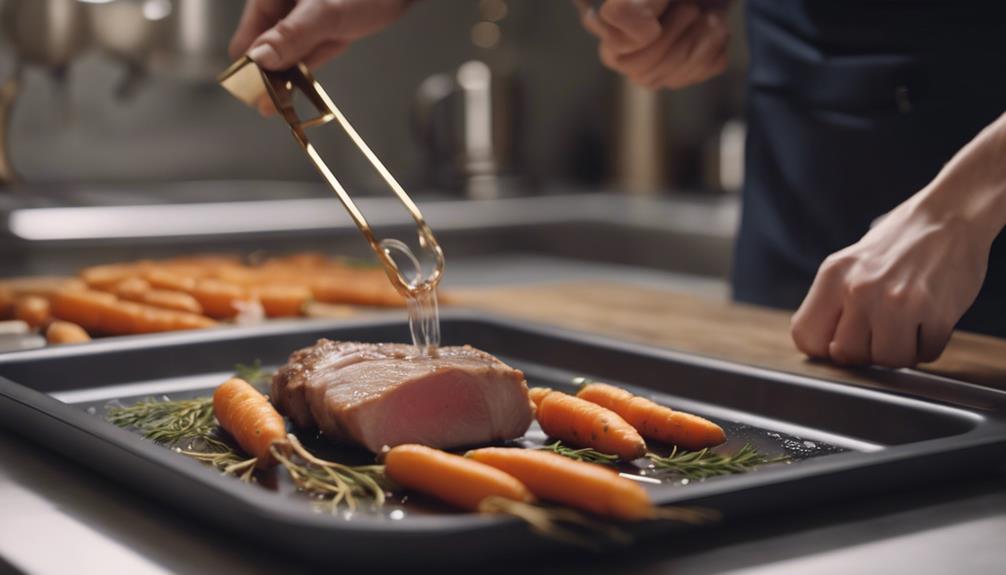
You're about to uncover the fascinating roots of sous vide cooking, exploring its origins, delving into its history, and tracing the evolution of this culinary technique.
Get ready to journey through time as you unravel the story behind the method that has revolutionized the way we cook and savor food.
From its humble beginnings to its modern-day popularity, the narrative of sous vide is a tale of innovation and precision.
Origins of Sous Vide
The inception of sous vide cooking can be traced back to the late 18th century, with the pioneering efforts of Sir Benjamin Thompson. This culinary technique, known for its precision cooking, has evolved into a modern innovation that continues to revolutionize the culinary world.
Sous vide, which translates to 'under vacuum' in French, involves sealing food in an airtight bag and cooking it in a water bath at a precisely controlled temperature. This method guarantees that the food is cooked evenly throughout, resulting in perfect texture and flavor.
Sir Benjamin Thompson's early experiments laid the foundation for what would become a game-changer in the culinary industry, inspiring chefs worldwide to explore the endless possibilities of sous vide cooking.
Sous Vide History
Delving into the origins of sous vide cooking reveals a rich tapestry of culinary evolution and innovation. The benefits of sous vide techniques lie in their ability to preserve flavors and nutrients by sealing ingredients in airtight bags and cooking them in a precisely controlled water bath.
This method originated in the 1960s in France, pioneered by Georges Pralus to cook foie gras consistently. Over time, sous vide has evolved to become a preferred cooking technique for chefs worldwide due to its ability to produce perfectly cooked dishes with enhanced flavors and textures.
The precision and control offered by sous vide techniques enable you to achieve restaurant-quality results in the comfort of your own kitchen, making it a valuable culinary skill to master.
Evolution of Sous Vide
Exploring the culinary roots of sous vide reveals a fascinating journey of innovation and gastronomic refinement.
The evolution of sous vide cooking traces back to the late 18th century when French chefs experimented with vacuum-sealing food in glass jars to preserve flavors.
Over time, technology advancements in the mid-20th century, particularly in the aerospace industry, paved the way for the modern sous vide method as it stands today.
The precision of temperature control and the ability to cook food evenly through water immersion have revolutionized culinary practices, allowing chefs to achieve unparalleled consistency and taste.
This evolution continues as sous vide becomes more accessible to home cooks, blending science and artistry to elevate dining experiences to new heights.
Key Ingredients for Flavor
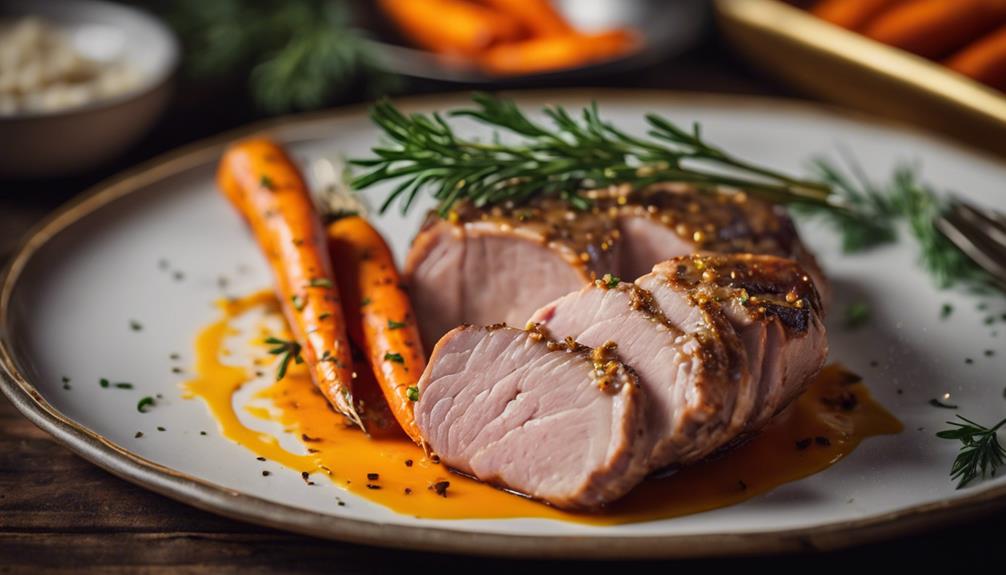
For added depth of flavor, consider infusing your sous vide pork tenderloin with aromatic spices and fresh herbs. Enhancing the taste of your dish can elevate the overall dining experience. Here are key ingredients to create a flavorful sous vide pork tenderloin:
- Flavor Profiles: Experiment with different combinations of spices such as smoked paprika, garlic powder, and cumin to develop a rich and complex flavor profile. These spices will infuse into the pork during the sous vide cooking process, creating a harmonious blend of tastes.
- Cooking Techniques: Utilize cooking techniques like searing the pork tenderloin after it has been sous vide to add a delicious caramelized crust and enhance the overall flavor. The Maillard reaction that occurs during searing will contribute depth and complexity to the dish.
- Seasoning Tips: Before vacuum-sealing the pork, generously season it with salt and pepper to make sure the flavors penetrate the meat. Additionally, consider marinating the pork tenderloin in a mixture of olive oil, fresh herbs like rosemary and thyme, and citrus zest for a delightful infusion of flavors.
Tasty Sous Vide Creations
Explore the endless possibilities of sous vide cooking with tantalizing dishes like savory pork medallions, pork belly tacos, and pork Wellington with cranberry glaze.
Elevate your culinary creations by experimenting with different cuts, flavors, and textures to craft unique and delectable meals.
Let your imagination run wild as you savor the delicious results of your sous vide adventures.
Savory Pork Medallions
Crafted with precision and finesse, these succulent pork medallions promise an exquisite sous vide experience that tantalizes the taste buds. When exploring savory pork medallions, consider the following:
- Pork Medallion Variations: Experiment with different cuts such as tenderloin, loin, or even sirloin for diverse flavors and textures.
- Cooking Techniques: Utilize sous vide for precise temperature control, ensuring a perfectly cooked and tender outcome every time.
- Flavor Enhancements: Elevate your dish with a variety of herbs, spices, and marinades to infuse the pork with rich, complex flavors.
Delight your guests with these delectable pork medallions that showcase the art of sous vide cooking at its finest.
Pork Belly Tacos
Have you ever experienced the tantalizing blend of flavors in perfectly cooked pork belly tacos, crafted with precision using the sous vide technique? When it comes to creating these delectable treats, the fusion of flavors is vital. Here's why:
- Melt-in-your-mouth texture: Sous vide cooking guarantees the pork belly is tender and juicy, allowing it to practically dissolve in your mouth with each bite.
- Flavor infusion: The sous vide method locks in the flavors of the marinade, herbs, and spices, resulting in a harmonious combination that elevates the taste of the pork belly.
- Versatile fusion cuisine: Pork belly tacos seamlessly blend the rich, savory flavors of pork belly with the vibrant, fresh elements of traditional taco fillings, creating a unique and memorable culinary experience.
Pork Wellington With Cranberry Glaze
Indulge in the exquisite culinary artistry of Pork Wellington with Cranberry Glaze, a tantalizing sous vide creation that guarantees a symphony of flavors in every bite. This elegant dish elevates the classic Pork Wellington by infusing it with a sweet and tangy cranberry glaze that adds a delightful twist to the traditional recipe. Here's why this dish is a must-try:
- Perfectly Sealed Flavors: The sous vide cooking method guarantees that the pork wellington is cooked to perfection, locking in all the juices and flavors for a succulent dining experience.
- Balanced Sweetness: The cranberry glaze offers a perfect balance of sweetness that complements the savory pork, creating a harmonious taste profile.
- Impressive Presentation: The Pork Wellington with Cranberry Glaze not only delights the taste buds but also impresses visually, making it an ideal choice for special occasions.
Searing Pork for Flavor
To elevate the taste of your pork, searing is essential.
The Maillard reaction that occurs during searing is vital for flavor development.
Achieving that perfect sear will make your pork tenderloin a culinary masterpiece.
Enhancing Pork Taste
For an intensified pork flavor profile, consider searing the pork tenderloin before sous vide cooking. Searing the tenderloin enhances its taste by creating a delicious crust that locks in juices and adds depth to the overall flavor.
Before searing, experiment with pork brining techniques to infuse the meat with additional flavors and guarantee tenderness. Marinating pork cuts in a mixture of herbs, spices, and acidic ingredients can further enhance taste by penetrating the meat with complex flavors.
When searing, make sure the pan is hot enough to create a caramelized exterior without overcooking the pork. By taking these steps, you elevate the pork's taste, making each bite a delightful experience for those you're serving.
Maillard Reaction Importance
Enhance the pork tenderloin's flavor by understanding the importance of the Maillard reaction when searing the meat.
The Maillard reaction is vital for flavor development, as it occurs when proteins and sugars are exposed to high heat, creating a complex array of new flavors and aromas.
When you sear the pork tenderloin after sous vide cooking, you initiate this reaction, resulting in a beautifully browned crust that adds depth and richness to the meat.
The Maillard reaction not only enhances the visual appeal of the dish but also adds immensely to the overall taste profile, making each bite a culinary delight.
Achieving Perfect Sear
Maximize the full potential of your pork tenderloin's flavor by mastering the art of achieving a perfect sear. Utilize searing techniques to enhance flavor development and achieve caramelization, elevating the taste of your dish to new heights.
Start by patting your pork tenderloin dry before searing it in a hot skillet with a touch of oil, creating a beautiful golden crust that locks in juices and adds depth to each bite. The Maillard reaction that occurs during searing not only enhances the visual appeal of your pork but also contributes to a more complex and savory flavor profile.
Perfecting the sear on your pork tenderloin is key to achieving a mouthwatering dish that will impress even the most discerning palates.
Final Thoughts
Consider incorporating these final thoughts to elevate your understanding of the Sous Vide Pork Tenderloin Recipe.
—
When preparing Sous Vide Pork Tenderloin, remember that flavorful marinades can enhance the taste profile substantially. Experiment with different combinations of herbs, spices, and acids to create a marinade that complements the pork's natural flavors. Additionally, take advantage of the Sous Vide benefits, such as precise temperature control, which guarantees consistent results every time.
To further enhance your culinary experience, mastering various cooking techniques is essential. Whether it's searing the pork after sous vide cooking or roasting carrots to accompany the dish, each method contributes to a well-rounded meal. Remember, temperature control is key in sous vide cooking; it ensures that your pork tenderloin is perfectly cooked to your desired doneness.
Below is a table summarizing key aspects to keep in mind when preparing Sous Vide Pork Tenderloin:
| Aspect | Importance | Tip |
|---|---|---|
| Flavorful Marinades | Enhance Taste | Experiment with different ingredients |
| Sous Vide Benefits | Consistent Results | Utilize precise temperature control |
| Cooking Techniques | Culinary Mastery | Explore various methods for best results |
Frequently Asked Questions
Can I Use a Regular Pot Instead of a Sous Vide Machine?
You can indeed use a regular pot for slow cooking as an alternative to a sous vide machine. By employing the boiling method, you can achieve tender results on your stovetop.
Simply seal your ingredients in a bag and submerge them in water in the pot. Maintain a consistent low temperature for a prolonged period.
This method offers a creative and effective way to prepare your dish, ensuring a delicious outcome.
How Can I Adjust the Cooking Time for a Larger Tenderloin?
When dealing with a larger tenderloin, adjusting the cooking time is essential for ensuring perfection.
With the pot method, maintaining temperature accuracy is crucial.
To adapt for a larger cut, simply increase the cooking time slightly while keeping an eye on the internal temperature.
This adjustment ensures that your tenderloin cooks evenly and reaches the desired level of doneness.
Enjoy your culinary journey as you master the art of sous vide cooking!
Can I Substitute the Carrots With Another Vegetable?
You can definitely swap the carrots for other vegetables to suit your taste. Consider vegetables like asparagus, zucchini, or bell peppers for a different flavor profile.
Try roasting or grilling the veggies to complement the sous vide pork tenderloin. For a colorful presentation, you can also sauté a mix of vegetables like cherry tomatoes and snow peas.
Experiment with different cooking techniques to enhance the overall dish and impress your guests.
What Is the Purpose of Searing the Pork After Sous Vide Cooking?
When you sear the pork after sous vide cooking, you're not just creating a beautiful crust; you're also enhancing its flavor through the Maillard reaction. This process adds depth and richness to the meat.
Additionally, the sear provides a delightful contrast in texture and boosts the dish's visual appeal. So, by taking this extra step, you elevate the overall taste experience of your pork tenderloin dish.
Can I Use a Different Cut of Pork for This Recipe?
When considering using different cuts of pork for this recipe, it's crucial to understand how various cuts behave with different cooking techniques. Some cuts might require longer cooking times or different temperatures to achieve best tenderness.
Experimenting with different cuts can offer unique flavors and textures, enhancing your culinary skills. Remember to adapt your cooking methods accordingly to guarantee a delicious outcome every time.
Conclusion
Indulge in the succulent flavors of sous vide pork tenderloin with roasted carrots, a dish that combines the tenderness of sous vide cooking with the rich flavors of searing.
Elevate your culinary skills with this impressive and delicious creation that will leave your taste buds craving for more. Experience the perfect harmony of textures and flavors in every bite, making this dish a standout favorite for any occasion.
Elevate your cooking game and impress your guests with this mouthwatering masterpiece.
